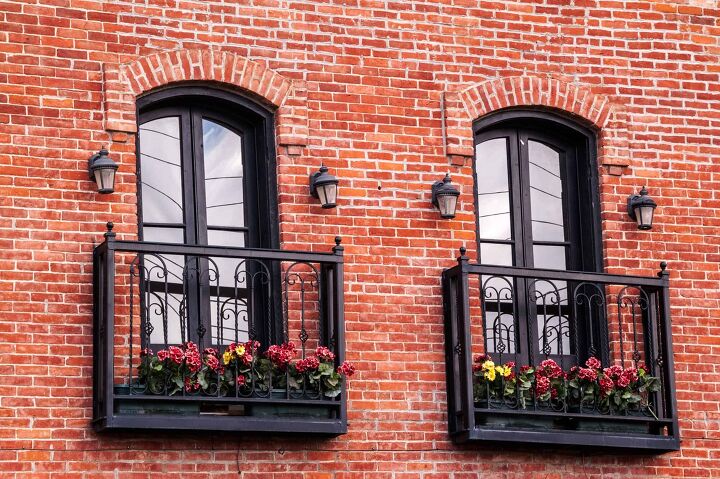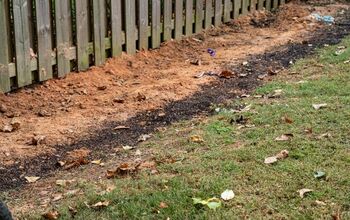What Is A French Balcony?

Picture Juliet stepping out onto her balcony to speak with Romeo, and you have the perfect image of a French balcony. There was just enough room for Juliet on her small perch. In fact, these balconies are often referred to as “Juliet balconies.”
A French balcony is more decorative than it is functional, offering a small space to stand or place some plants. You won’t find much room on a French balcony for lounging about or placing large items like furniture.
Typically, a French balcony consists of a rail placed across French windows or doors to give the illusion of a full balcony.
French balconies can be found in a number of settings including apartment buildings, homes, and even cruise ships. They can also be found in interior courtyards, adding a touch of charm and whimsy.
Why Are They Called French Balconies?
French balconies, also called “Juliet balconies,” were popularized in 18th century Georgian Britain, an era named after the Hanoverian kings George I, George II, George III and George IV. During this time, architects used French balconies to add flair to the outside of buildings. Additionally, these balconies also offered ventilation and light for the interior.
The alternate name “Juliet” is a direct reference to Shakespeare’s Romeo and Juliet. Although the balcony itself is not mentioned in the text, Shakespeare wrote that Juliet spoke to Romeo out of her bedroom window. Performances of Romeo and Juliet frequently utilized balconies (and still do), so the nickname was born.
Do You Need an Addition or Remodel Contractor?
Get free, zero-commitment quotes from pro contractors near you.

How Big Is the Average French Balcony?
Size is the most significant difference between a French balcony and a traditional balcony. French balconies, also called false balconies, are not very large. In fact, many of them offer little to no space beyond the door or window.
Regular balconies can vary greatly in size. Some of the largest traditional balconies can be deep enough to fit multiple people and furniture. You can place a collection of tables and chairs to enjoy outdoor meals with family and friends.
The smallest traditional balcony measures about 1.5 to 2-feet deep, just enough room for one person to stand comfortably. (Or two people to squeeze together). In contrast, the “largest” French balcony would fit one person (like Juliet).
Think of a French balcony as a small extension past a window or door, nothing more. Sometimes, a French balcony can offer such little depth that it becomes completely decorative. In these cases, you might not even be able to fit a potted plant.
What Are the Benefits of a French Balcony?
If a French balcony doesn’t function as a balcony, what does it do? Why would you want to opt for a French balcony instead of a traditional balcony?
First, there are many situations in which a regular balcony is not possible. Your house could not have the right support, you can’t get the proper permit, or you don’t have the budget. Or, an apartment dweller does not have the option to expand the space to include a balcony and bring in fresh air or a better view. This is especially true in vertical city living where every single square inch matters. In these cases, a French balcony can be a good alternative.
French balconies have several benefits:
- Aesthetics
- Safety
- Low Maintenance
- Let the Light and the Outside In
- Illusion of Space
- Garden Space
Aesthetics
French balconies can add a lot of aesthetic appeal to your property. They provide an architectural detail that elevates your home’s visual interest.
These mini-balconies come in many styles, shapes, and colors, making it easy to find a look that meshes with your home. The balustrade, or rail, can be made of vinyl, wood, metal, or other materials, and be straight, angled, or rounded.
Safety
If you have a home with young children, railings across upper-level exterior doors and windows provide extra safety. You can enjoy the open and airy feeling of having your windows open without fear of children or pets falling.
Of course, the style of balustrade you choose also influences the safety level of your balcony. Think about how much space is between each spindle, or consider getting a completely solid balustrade.
Low Maintenance
If you want the look of a balcony without the upkeep, a French balcony requires little maintenance. Plus, you can have outdoor access on higher levels where there might not be structural support for a full balcony.
Let the Light and Outside In
Opening up a set of wide doors on an upper floor can make the entire room feel like a balcony. Beautiful natural light floods into the room, and you get a sense of bringing the outside in.
Along with this outdoor access also comes an increase in ventilation. When the weather is nice, you can keep your French doors open and enjoy the breeze.
Illusion of Space
Although a French balcony does not provide much physical space, it tricks the eye. You feel as if there is more space when you see what appears to be a balcony outside of windows and doors.
Plus, when you can open exterior doors on your home’s upper levels, this also provides a sense of extra space.
Garden Space
If you live in a highrise condo or an apartment with little outdoor space, it can be hard to keep a garden. A French balcony gives you the perfect place to develop your green thumb.
You can showcase more of your favorite plants than you could with a simple window box. Plus, you can care for your garden easily, even on the upper floors.
What Type of French Balcony Should I Choose?
When it comes to the style and materials of French balconies, you have many options to choose from. For a more modern look that has less of an influence on architecture, consider selecting a glass French balcony. Whereas, a wooden French balcony can convey an array of styles, with the most common being a very natural look.
For an elegant aesthetic, metal is an excellent material for French balconies. Although French balconies are sometimes poorly executed, when done right, they can be a stunning focal point and also be incredibly safe.
A cable railing system is the ideal choice for safety. They also offer beauty and longevity to your French balcony.
Related Questions
Is a French balcony the same thing as a veranda?
A French balcony and veranda are not the same thing, although the words are often used interchangeably. A balcony of any kind is used on upper floors, while a veranda is on the ground floor of a home and usually covered.
Can a French balcony be on the inside of a house?
Although not common, you can install a French balcony on the inside of your home to create visual interest. It can create a mezzanine effect, or look especially nice if your home has an interior courtyard-style area. You often see French balconies on the interior of different businesses like restaurants, hotels, and casinos. In these settings, false balconies are often used to create an illusion of being outside.
How much does a French balcony cost to install?
A French balcony can cost as little as $500 to install since it does not require a lot of structural support. This is compared to a traditional balcony which costs anywhere from $2,000 to over $10,000. Of course, the actual price depends on several factors like size, materials, and style. Also, consider if you feel comfortable installing the balcony yourself or if you need to hire a pro.
Do you need a permit to install a French balcony?
Although a French balcony is mostly decorative, you still might need a permit. Every city and state has its own building code, so depending on where you live, you may or may not need a permit.However, one of the main reasons that French balconies are becoming very popular in the UK is that they can often be installed without the need for planning permission. This effectively eliminates the need for an architect to be involved and reduces costs significantly.Regardless, before you install your French balcony, you should still check with your local permit office to ensure you don’t skip any necessary steps. Otherwise, you could end up having to remove the balcony.
Do You Need an Addition or Remodel Contractor?
Get free, zero-commitment quotes from pro contractors near you.

Wrapping Up
Basically, a French balcony is more decorative than it is functional. It provides the illusion of a full balcony without all of the upkeep and maintenance.
A balconette is also an ideal choice for homes that don’t have enough structural support for a full balcony. Depending on the size, a mini-balcony can give one person standing room, or display a few decorative pieces.
If you want to enjoy an evening breeze on your home’s upper levels, a French balcony does the trick. It’s also a great way to showcase flowers and plants or keep a garden if you live in an apartment.
If you’re thinking about installing a French balcony, the cost and upkeep are minimal. You just might want to think twice before installing one outside of your daughter’s room — don’t forget about Juliet!

Stacy Randall is a wife, mother, and freelance writer from NOLA that has always had a love for DIY projects, home organization, and making spaces beautiful. Together with her husband, she has been spending the last several years lovingly renovating her grandparent's former home, making it their own and learning a lot about life along the way.
More by Stacy Randall



























